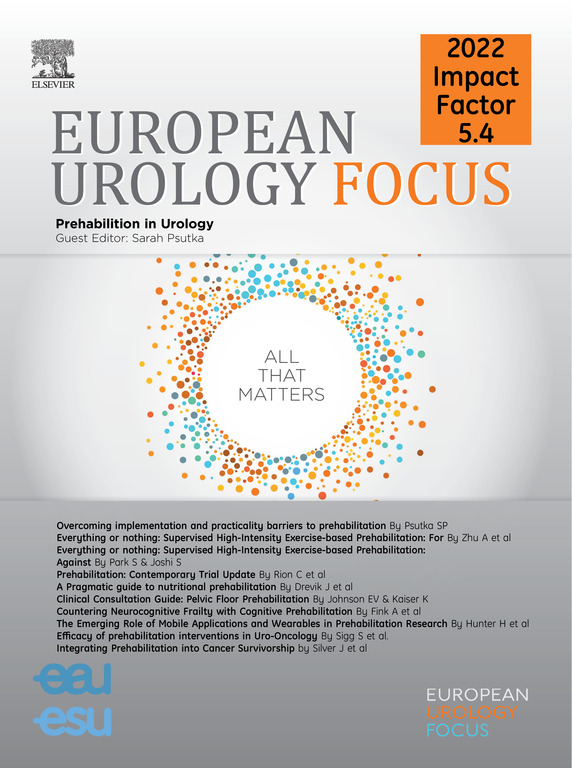经会阴或经直肠磁共振成像靶向活检用于前列腺癌检测。
IF 4.8
2区 医学
Q1 UROLOGY & NEPHROLOGY
引用次数: 0
摘要
背景和目的:随着经直肠活检(TRBx)向经会阴活检(TPBx)过渡,严重尿路感染的风险降低,前列腺活检方法的选择出现了明显的范式转变。这一变化对临床意义重大的前列腺癌(csPCa)检测的影响仍存在争议。我们的目的是比较 TRBx 和 TPBx 的 csPCa 检出率:方法:纳入2016年至2023年期间在15个欧洲转诊中心接受磁共振成像(MRI)靶向和系统性活检治疗临床局部PCa的患者。进行倾向评分匹配(PSM)分析以尽量减少选择偏差。采用逻辑回归模型估算调整后的几率比(OR)和95%置信区间(CI):在符合研究标准的 3949 名患者中,2187 人接受了 TRBx,1762 人接受了 TPBx。通过PSM分析得出了1301对匹配的患者。配对组患者的人口统计学特征和肿瘤特征具有可比性。TPBx 与 TRBx 相比,csPCa 的检出率更高,无论是定义为国际泌尿病理学会分级组≥2(51% vs 45%;OR 1.37,95% CI 1.15-1.63;p = 0.001)还是分级组≥3(29% vs 23%;OR 1.38,95% CI 1.13-1.67;p = 0.001)。如果仅考虑核磁共振靶向活检,以及根据肿瘤位置、前列腺成像报告和数据系统评分以及临床特征对患者进行分层后,结果也相似。研究的局限性包括研究的回顾性和缺乏集中的磁共振成像审查:我们的研究结果增强了人们对TPBx额外优势的认识。患者摘要:我们比较了磁共振成像(MRI)引导下活检与会阴或直肠穿刺活检对有临床意义的前列腺癌的检出率。我们的结果表明,会阴部方法能更好地发现侵袭性前列腺癌。本文章由计算机程序翻译,如有差异,请以英文原文为准。
Transperineal or Transrectal Magnetic Resonance Imaging–targeted Biopsy for Prostate Cancer Detection
Background and objective
A notable paradigm shift has emerged in the choice of prostate biopsy approach, with a transition from transrectal biopsy (TRBx) to transperineal biopsy (TPBx) driven by the lower risk of severe urinary tract infections. The impact of this change on detection of clinically significant prostate cancer (csPCa) remains a subject of debate. Our aim was to compare the csPCa detection rate of TRBx and TPBx.
Methods
Patients who underwent magnetic resonance imaging (MRI)-targeted and systematic biopsies for clinically localized PCa at 15 European referral centers from 2016 to 2023 were included. A propensity score matching (PSM) analysis was performed to minimize selection biases. Logistic regression models were used to estimate adjusted odds ratios (ORs) and 95% confidence intervals (CIs).
Key findings and limitations
Of 3949 patients who met the study criteria, 2187 underwent TRBx and 1762 underwent TPBx. PSM resulted in 1301 matched pairs for analysis. Patient demographics and tumor characteristics were comparable in the matched cohorts. TPBx versus TRBx was associated with greater detection of csPCa, whether defined as International Society of Urological Pathology grade group ≥2 (51% vs 45%; OR 1.37, 95% CI 1.15–1.63; p = 0.001) or grade group ≥3 (29% vs 23%; OR 1.38, 95% CI 1.13–1.67; p = 0.001). Similar results were found when considering MRI-targeted biopsy alone and after stratifying patients according to tumor location, Prostate Imaging-Reporting and Data System score, and clinical features. Limitations include the retrospective nature of the study and the absence of centralized MRI review.
Conclusions
Our findings bolster existing understanding of the additional advantages offered by TPBx. Further randomized trials to fully validate these findings are awaited.
Patient summary
We compared the rate of detection of clinically significant prostate cancer with magnetic resonance imaging (MRI)-guided biopsies in which the sample needle is passed through the perineum or the rectum. Our results suggest that the perineal approach is associated with better detection of aggressive prostate cancer.
求助全文
通过发布文献求助,成功后即可免费获取论文全文。
去求助
来源期刊

European urology focus
Medicine-Urology
CiteScore
10.40
自引率
3.70%
发文量
274
审稿时长
23 days
期刊介绍:
European Urology Focus is a new sister journal to European Urology and an official publication of the European Association of Urology (EAU).
EU Focus will publish original articles, opinion piece editorials and topical reviews on a wide range of urological issues such as oncology, functional urology, reconstructive urology, laparoscopy, robotic surgery, endourology, female urology, andrology, paediatric urology and sexual medicine. The editorial team welcome basic and translational research articles in the field of urological diseases. Authors may be solicited by the Editor directly. All submitted manuscripts will be peer-reviewed by a panel of experts before being considered for publication.
 求助内容:
求助内容: 应助结果提醒方式:
应助结果提醒方式:


